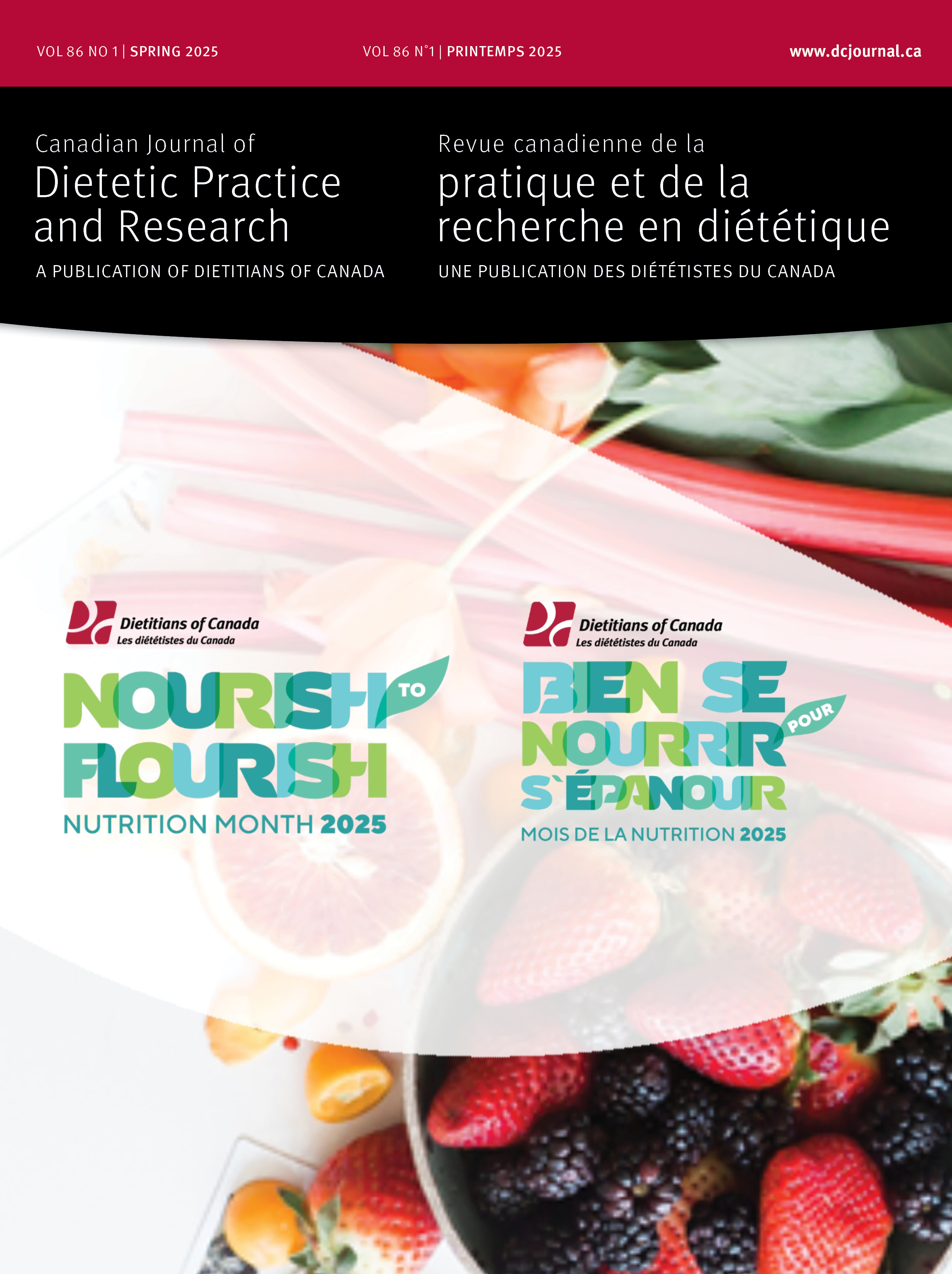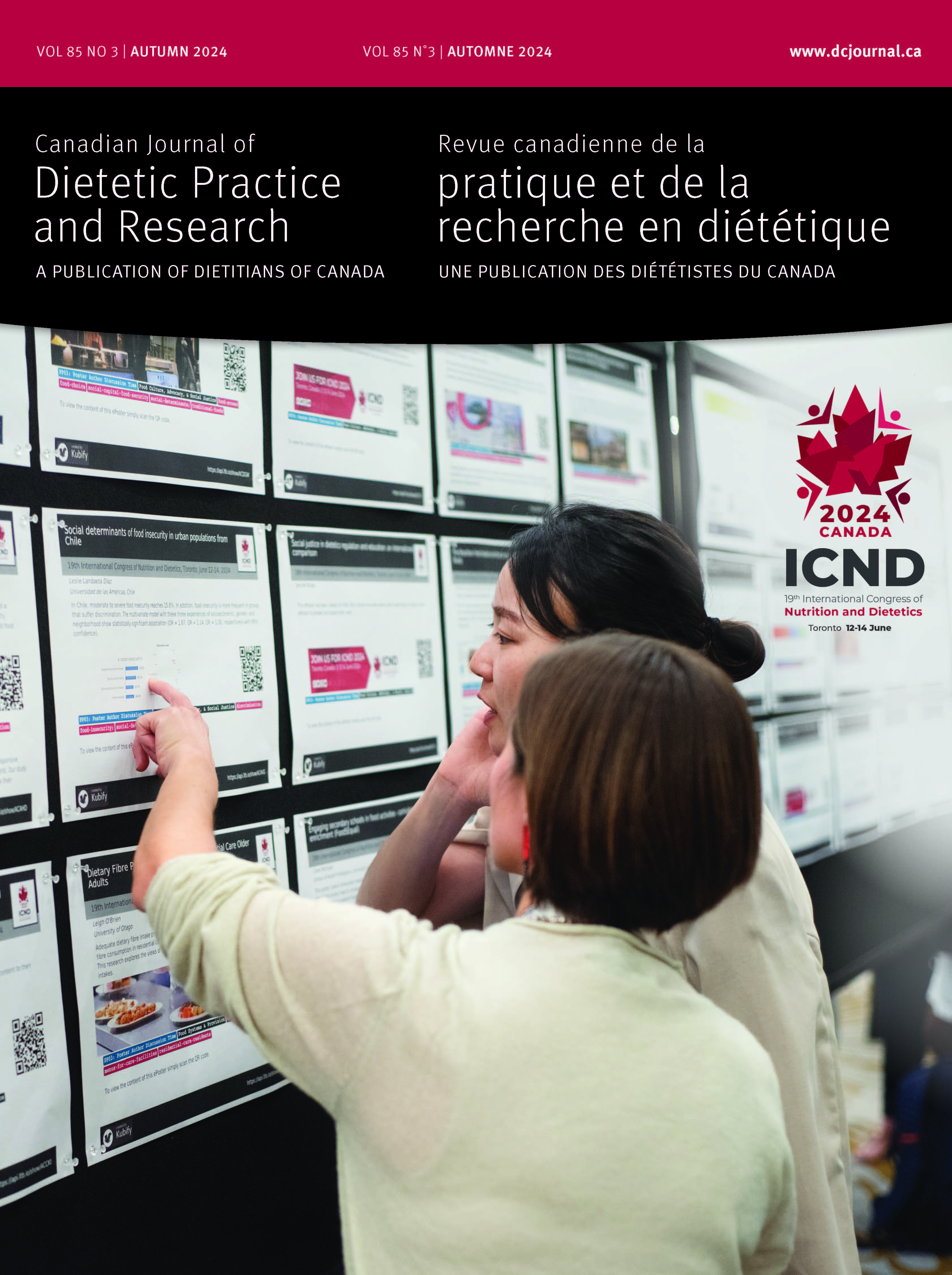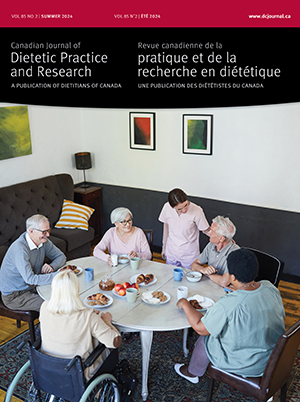Volume 80 • Number 3 • September 2019
Editor’s Message
Research
Purpose: To describe prenatal nutrition care currently delivered by Family Health Teams (FHTs) and Community Health Centres (CHCs) in Ontario, from the perspectives of health care providers, and to identify opportunities for improving care.Methods: Ten 1-hour, interdisciplinary focus groups were conducted in FHTs and CHCs, involving a total of 73 health care providers. Focus groups ranged in size from 3 to 11 team members, and at least 3 different professions participated in each group. The shared perspectives and experiences on prenatal nutrition care were collected using a semi-structured interview guide and analyzed using thematic analysis.Results: Limited time was spent on prenatal nutrition education and counselling. Two themes emerged describing gaps in care: (i) providing care in “borderline” high-risk pregnancies (i.e., impaired glucose tolerance) and (ii) providing care around gestational weight gain. Providers envisioned improving services offered by increasing preventative care, empowering providers to provide more nutrition care, facilitating patient self-care, and building a 1-stop shop “medical home”.Conclusions: This study’s findings can guide strategies to mobilize current nutritional knowledge into routine prenatal care, and the shared vision for improvement will inform the routes for new practice that are supported by health care professionals.
Purpose: To describe the prevalence and characteristics of modified-texture food (MTF) consumers when applying standard diet terminology.Methods: Making the Most of Mealtimes (M3) is a cross-sectional multi-site study including 32 long-term care (LTC) homes located in 4 Canadian provinces. Resident characteristics were collected from health records using a defined protocol and extraction form. Since homes used 67 different terms to describe MTFs, diets were recategorized using the International Dysphagia Diet Standardization Initiative Framework as a basis for classification.Results: MTFs were prescribed to 47% (n = 298) of participants (n = 639) and prevalence significantly differed among provinces (P < 0.0001). Various resident characteristics were significantly associated with use of MTFs: dysphagia and malnutrition risk, dementia diagnosis, prescription of oral nutritional supplements; lower body weight and calf circumference; greater need for physical assistance with eating; poor oral health status; and dependence in all activities of daily living.Conclusions: This is the first study that used a diverse sample of LTC residents to determine prevalence of MTF use and described consumers. The prevalence of prescribed MTFs was high and diverse across provinces in Canada. Residents prescribed MTFs were more vulnerable than residents on regular texture diets. These findings add value to our understanding of MTF consumers.
Perspectives in Practice
We estimated calorie intake from alcohol in Canada, overall and by gender, age, and province, and provide evidence to advocate for mandatory alcohol labelling requirements. Annual per capita (aged 15+) alcohol sales data in litres of pure ethanol by beverage type were taken from Statistics Canada’s CANSIM database and converted into calories. The apportionment of consumption by gender, age, and province was based on data from the Canadian Tobacco, Alcohol and Drug Survey. Estimated energy requirements (EER) were from Canada’s Food Guide. The average drinker consumed 250 calories, or 11.2% of their daily EER in the form of alcohol, with men (13.3%) consuming a higher proportion of their EER from alcohol than women (8.2%). Drinkers consumed more than one-tenth of their EER from alcohol in all but one province. By beverage type, beer contributes 52.7% of all calories derived from alcohol, while wine (20.8%); spirits (19.8%); and ciders, coolers, and other alcohol (6.7%) also contribute substantially. The substantial caloric impact of alcoholic drinks in the Canadian diet suggests that the addition of caloric labelling on these drinks is a necessary step.
While the title Registered Dietitian (RD) is regulated under provincial legislation in Ontario and other Canadian provinces, the title “nutritionist” is not regulated in Ontario, which poses potential risks to consumers who place misguided trust in those proclaiming to be nutrition experts. This is concerning as nutrition is a complex health care discipline and RDs, the recognized providers of credible nutrition information, must be registered with an accredited regulatory college that requires them to have undergone rigorous training, practicum placements, entrance examinations, and continuous professional development. The purpose of this study was to determine if Ontario-based unregulated nutritionists and RDs are providing safe, evidence-based, information regarding detoxification diets. Content from 10 blog posts were qualitatively analyzed using deductive content analysis with predetermined categorization matrices. The results revealed that Ontario nutritionists promoted detox diets and provided unproven, misleading, and potentially harmful information, whereas Ontario RDs did not promote detox diets and provided evidence-based, harm-reducing information. Additionally, conflicts of interest arose only in nutritionists’ blog posts. RDs provided credible references for their information while nutritionists did not. Protecting the term “nutritionist” for use exclusively by RDs under provincial legislation would be a positive step towards ensuring Ontarians are receiving the highest quality evidence-based nutrition information.
Many long-term care (LTC) residents have an increased risk for dysphagia and receive texture-modified diets. Dysphagia has been shown to be associated with longer mealtime duration, and the use of texture-modified diets has been associated with reduced nutritional intake. The current study aimed to determine if the degree of diet modification affected mealtime duration and to examine the correlation between texture-modified diets and dysphagia risk. Data were collected from 639 LTC residents, aged 62–102 years. Nine meal observations per resident provided measures of meal duration, consistencies consumed, coughing and choking, and assistance provided. Dysphagia risk was determined by identifying residents who coughed/choked at meals, were prescribed thickened fluids, and/or failed a formal screening protocol. Degree of texture modification was derived using the International Dysphagia Diet Standardization Initiative Functional Diet Scale. There was a significant association between degree of diet modification and dysphagia risk (P < 0.001). However, there was no association between diet modifications and mealtime duration, even when the provision of physical assistance was considered. Some residents who presented with signs of swallowing difficulties were not prescribed a texture-modified diet. Swallowing screening should be performed routinely in LTC to monitor swallowing status and appropriateness of diet prescription. Physical assistance during meals should be increased.
The Nutrition Care Process (NCP), created by the Academy of Nutrition and Dietetics, provides a framework that encourages critical thinking and promotes uniform documentation by Registered Dietitians (RD). Additionally, it creates a link between the nutrition assessment, nutrition intervention, and the predicted or actual nutrition outcome. NCP has been integrated into a number of institutions in Canada and internationally. A committee of nonmanagement RDs at the Hospital for Sick Children led the Department of Clinical Dietetics in adopting the NCP. The committee developed and consecutively delivered a tailored education plan to 5 groups of RDs within the department. Additional resources were developed to complement the learning plan. The committee administered informal pre- and post-education surveys to measure outcomes. RDs reported receiving adequate training and felt confident implementing NCP into their practice. Adopting the NCP was well-received and RDs within the department continue to integrate it into their current practice.
Review
At least 5% of women have an eating disorder (ED) during pregnancy. These EDs affect prepregnancy body mass index (BMI) and weight gain during pregnancy, factors associated with birth complications and adverse neonatal outcomes. This review contributes to the literature by examining several adverse birth outcomes associated with EDs and differentiates between past and present EDs. Of the 18 articles reviewed, EDs were associated with preterm birth in 5/14 (36%) and small-for-gestational-age in 5/8 (63%) studies. Anorexia Nervosa increases the odds of a low birth weight baby, particularly when women enter pregnancy with a low BMI. Binge Eating Disorder is positively associated with having a large-for-gestational-age infant, and Bulimia Nervosa is associated with miscarriage when symptomatic during pregnancy. Having a current ED increases the risk for adverse birth outcomes more than a past ED. Since the aetiology of adverse birth outcomes is multi-factorial, drawing conclusions about causal relationships between EDs and birth outcomes is problematic given the small number of studies reporting these outcomes. Resources should target preconception interventions that put EDs into remission and help women achieve a healthier BMI prior to pregnancy, as these have been consistently shown to improve birth outcomes.
Report
Purpose: As Canada rethinks approaches to food guidance, insights into the needs of seniors in rural communities are important to ensure their nutrition issues are addressed. This study aimed to explore the food guidance needs and wants of a group of seniors living in Antigonish, Nova Scotia.Methods: Three focus groups were held with a total of 12 participants over the age of 65 years, living independently in the community. Seniors were asked about their views on Canada’s Food Guide (CFG) and the Brazilian Dietary Guidelines (BDG).Results: Participants identified CFG as a trusted source of information and related well to the food groups and directive statements. Portion sizes were confusing and advice on food choices was not seen as being realistic in terms of cost and availability. The holistic nature of the BDG was appealing but guidance on processed food and social eating was not seen as relevant. Neither guidance tool addressed concerns about sustainability and environmental issues. Point of purchase nutrition information was preferable to receiving it from health professionals.Conclusion: CFG was seen as a trusted source of advice; however, locally accessible guidance on affordability and environmental issues related to food choice is needed for this group.
Recognition
OPEN ACCESS
Being different is neither right nor wrong; it is just different. The dietetic profession as part of society holds many differences. These can be divisive, but learning to recognize the strengths that differences generate could lead to a stronger professional future. Three points arose when reflecting on professional experiences of a career of more than 3 decades. Recognizing different ways of creating and gathering knowledge, leading individuals and teams, and valuing the past as well as the future, will provide opportunities to explore our differences as individuals and as a profession. These themes appear at the intersections of values that could initiate inclusion or exclusion. Learnings from these intersections note that growth can occur even in the midst of adversity. Without understanding the junctions in our professional pathways, futures planning may not build upon the foundation of strengths, experiences, and values present within our profession. Learning to be a risk taker, to walk into the fear, has helped Laurie to shape a career that feels satisfying and successful. Suggested techniques to energize individual careers are provided.
Canadian Foundation for Dietetic Research
OPEN ACCESS
Through the support of Dietitians of Canada (DC) and the Canadian Foundation for Dietetic Research (CFDR), the 2019 Research Showcase at the DC conference represented a wide variety of practice-based nutrition research projects in Canada.The 2019 Research Showcase consisted of several new elements this year. Early Bird abstracts were considered for either oral or oral ePoster sessions. New this year was the presentation of 11 Early Bird abstracts as oral presentations within the regular conference sessions: we called these “Lightning Rounds”. The remaining 27 Early Bird abstracts were presented as oral ePosters on June 6, 2019; authors presented their research in 2–3 minutes plus 2 minutes for questions, using their ePosters. For 2019, there were 3 concurrent oral ePoster sessions. All accepted, and presented, abstracts from the Early Bird submission are published in the Journal.This research event would not be possible without the commitment and dedication of many people. On behalf of DC and CFDR, we extend a special thank you to members of our abstract review committee: Susan Campisi (University of Toronto); Elaine Cawadias (Retired); Andrea Glenn (St. Francis Xavier University); Brenda Hartman (Brescia College, Western University) Mahsa Jessri (University of Ottawa); and Jessica Lieffers (University of Alberta).Thanks also to our moderators for the Oral ePosters: Barb Anderson (Acadian University); Jane Bellman (Dietitians of Canada); Brenda Hartman (Brescia College, Western University); Jessica Lieffers (University of Alberta); Dawna Royall (Dietitians of Canada); and Lee Rysdale (Northern Ontario School of Medicine).We enjoyed interacting with many of you at the oral research presentations as we highlighted the findings from our dietetic colleagues across our country!Finally, a special thank you to Gareth Willows Tribe and Michelle Naraine at CFDR for their assistance and support throughout the review process.Christina Lengyel, PhD, RDChair, 2019Early Bird CommitteeAssociate ProfessorDirector of the Dietetics ProgramHuman Nutritional SciencesUniversity of ManitobaJanis Randall Simpson, PhD, RD, FDCChair, 2019Late Breaking CommitteeProfessor EmeritaUniversity of GuelphExecutive Director, CFDR










